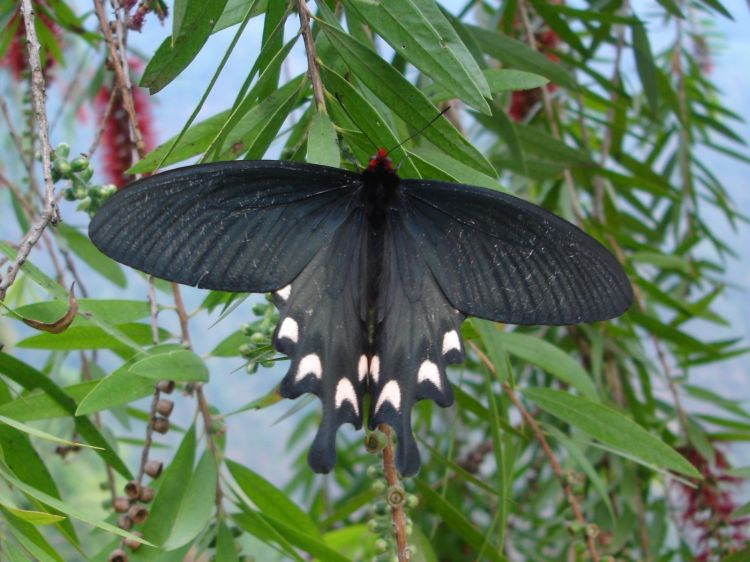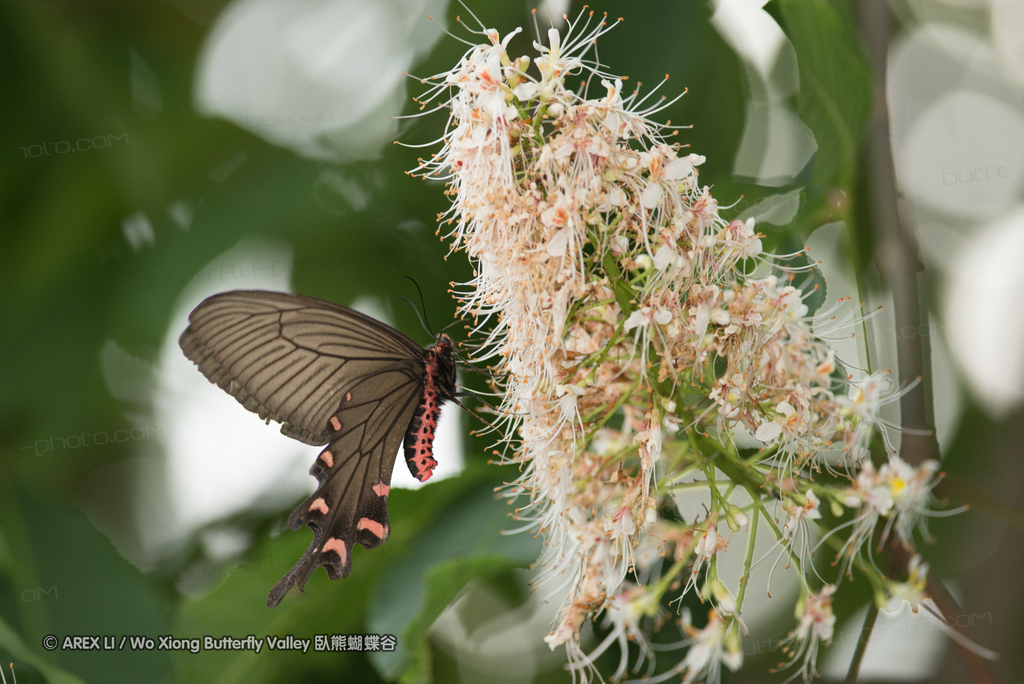This week's butterfly, Atrophaneura or Byasa or Papilio plutonius, has the English nicknames "Pink-Spotted Windmill" and "Chinese Windmill." "Chinese Windmill" is commonly used but can also refer to A. alcinous.
Though the butterfly is somewhat rare, only two subspecies are believed to be endangered. About half a dozen subspecies have been identified; most live in China and have not been extensively studied. The subspecies found in India are considered seriously endangered there. Plutonius is found in forests in China, India, and other countries, at high altitudes. It favors tropical forests with rich black soil, temperatures between 25 and 28 degrees Celsius, and an average annual rainfall of about 120 centimeters--over 4 feet. Paul Van Gasse described it:
"
Byasa plutonius (Chinese Windmill)
B.p.pembertoni: Rare in Himalayas, 1500 to 2750m, from all across Nepal east
through Sikkim to Bhutan. – Pemberton’s Chinese Windmill
B.p.tytleri: Rare in higher hills of NE India south of Brahmaputra (Nagaland and
Manipur). (= impediens) – Tytler’s Chinese Windmill
[Given as Tros alcinous, Chinese Windmill, with subspecies Tros alcinous
pembertoni, Pemberton’s Chinese Windmill, and Tros alcinous tytleri, Tytler’s
Chinese Windmill; recently often given as Atrophaneura plutonius]
"
Subspecies pembertoni. Photo donated anonymously to Wikiwand.
Peter Smetacek has photos of tytleri, in which the dark shading around the spots is more conspicuous than the reddish or whitish spots themselves.
Byasa plutonius pembertoni and tytleri are, however, on the protected list of butterflies whose carcasses may not be sold internationally. These subspecies have been called "critically endangered." Customs officials are advised to watch for them, noting the four to five-inch wingspan, the lack of markings above with only faint, often yellowish traces of the pinkish spots bordering their hind wings, and the long hind wings and tails of pembertoni. Tytleri may have whitish and/or reddish spots. Both show the classic Atrophaneura color, black fading to drab along the veins, sometimes faded to white between the veins. Both have the "windmill" shape, with relatively long narrow wings that can be spread out into an X shape. The hind wings are deeply scalloped, not growing into extra "tails" as some swallowtails' wings do, but close to it.
An early author wrote that plutonius could not be confused with philoxenus because of "the pale greenish brown color of the female, the shape of the red spots,[and] the longer and thinner shape of the hind wings." The long straight "tails" on the hind wings distinguished it from mencius. It was most like alcinous, but the hind wings are longer and thinner than those of alcinous too.
However, plutonius generally is not hard to find if people look in the right place and time. It appears on lists like this one, which notes that the butterfly was photographed but does not include the photograph:
For a party interested primarily in birds, plutonius was an interesting sight but another, more colorful Swallowtail was much more interesting.
Like other Red-Bodied Swallowtails, it is large, dark, able to fly steadily at a low speed and to fly high in the air, and apt to lurk in dark forests where it may fade into the shadows or dart out unexpectedly. Although these species are relatively clean-living pollinators, not the composters who preside over many animals' "funerals," their black wings suggested funeral attire and the species named in the eighteenth century received names associated with funerals in ancient literature. Hence plutonius, "butterflies of the Wealthy One." The mythical king of the underworld was Pluto, the Wealthy One, who had received the powers and treasures of so many rich people.
Eresha Fernando and others believe that all subspecies of plutonius are decreasing in numbers, and the entire species may soon qualify as endangered.
In Denmark, otoh, an observation of alcinous flitting about raised fears that alcinous or plutonius might become invasive species. Meh. It wouldn't be the first time one person's exotic pets went feral and became other people's invasive pests, but the habits of plutonius don't sound as if this species is likely to become a pest in northern Europe.
Even in China, where plutonius has most often found congenial habitat, there is concern about these large, less-than-prolific butterflies' ability to coexist with human greed. Nature provides checks and balances on most of the large butterflies' populations. They seem meant to be rare. Simple species counts, in places where plutonius are found, may turn up two or three hundred of some other kind of swallowtail and two plutonius. If the butterflies of the Wealthy One don't spread themselves over their territory as determinedly as our Monarchs do, still, a similar dynamic is observed. Female butterflies look for previously unused host plants on which to lay eggs, and males follow females. Each viable egg needs a host plant of its own to give the caterpillar a chance to survive. Most caterpillars won't survive, anyway. They could easily become extinct, or at least locally extinct.
And oh, the paparazzi, they would undoubtedly say if they could talk. At no time in its life has this butterfly been able to sting, nor to convince anyone that it could. It is just trying, by unconscious reflexes similar to the ones that cause most humans to avoid contact with insects, to get itself right-side-up while some researcher thinks its underside is more interesting. It is not in great pain or danger, but it is uncomfortable.
Admitted work of Frank Model. This web site looks forward to a book in which he appears with his shoes on the wrong feet, having buckets of ice dumped over his head and his face washed with snow, lying on the bottom of a pool breathing up bubbles, and otherwise showing that butterfly his own tolerance for positions that are not terribly painful or dangerous but are uncomfortable for humans. We are built to sleep comfortably on our relatively wide flat backs, and don't always realize that most animals are not built to tolerate lying on their backs for ten seconds.
The butterfly has reasons for alarm. Although the urge to kill butterflies and store their bodies in boxes does not seem to be felt by people who know about digital photography, a few older people still keep boxes of butterfly carcasses, and a plutonius in good condition can be sold for money...though if it happens to be pembertoni or tytleri, the buyer and seller can be fined. Once again this web site reiterates: If you watch butterflies for very long you will acquire dead bodies honestly, as most live only a month or two after their wings unfold and many big swallowtails have less time than that, but we should never pay money for a dead butterfly or part of one. Butterfly collectors now hoard digital photos.
Apart from its helplessness to resist harassment when it is found, little is known about the lives of Byasa plutonius. They seem to be pollinators more than composters.
Photo donated to Inaturalist.org by Arex. This is the way to get a photo of the underside of a butterfly's wings, which are often quite different from the upperside and often what people actually see. You find something the butterfly can eat (or drink--all butterflies follow a strict liquid diet) and wait for it to hold its wings straight up, as most butterflies do, while eating.
They can be bold and curious, like our swallowtails.
They've been renamed more than most of the Byasas. In addition to the usual movement through classification as Papilio, then Atrophaneura, and then Byasa, plutonius has also been assigned to the genera Tros and Parides. In fact, many scientists being more interested in quibbling about how much in danger a species or subspecies is than in protecting it, DNA studies have been done on how different pembertoni and tytleri are from the other plutonius.
Some people in China and India have probably observed the life cycle of Byasa plutonius, but information about what it eats, when and where the eggs are laid, how long they take to hatch, what the caterpillar looks like, whether two caterpillars can survive on one food plant, when it pupates, and when it emerges from the pupa, is completely unavailable on the Internet.





No comments:
Post a Comment